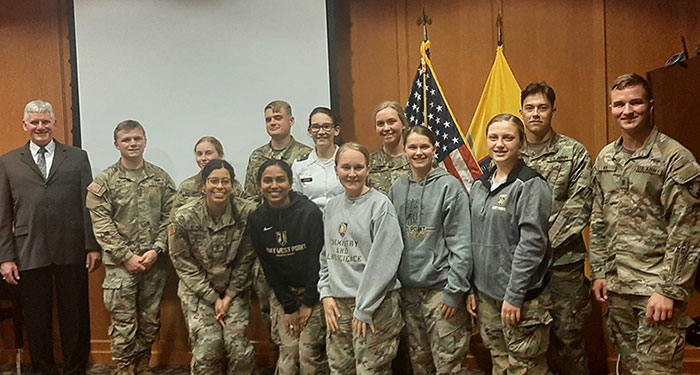USAMRDC, West Point Collaborate on Research, More

Late last month, representatives from the U.S. Army Medical Research and Development Command traveled to the U.S. Military Academy in West Point, New York, to lead a series of presentations on technical innovation and medical research initiatives. The effort is notable in that it marks an attempt to expand and boost collaboration between the two entities as USMA continues its focus on a slew of new research projects – a significant expansion in scope for the historically academic-focused institution.
"Many of the cadets who attended are going to medical school after graduation, and depending on their specialty they may be in the Army for 12 to 13 years or longer," said Dr. Edward Diehl, commercialization officer in USAMRDC's Technology Transfer Office (formally known as the Office of Research and Technical Applications), who gave a series of presentations to USMA cadets as well as both faculty and staff. "So this is part of the future, to educate those becoming physicians about technology development - what we're looking for and how to participate in it."
Indeed, Diehl's forums and conversations with USMA cadets – in which he highlighted USAMRDC's desire to identify new inventions for the purposes spotting and securing new patents for the Army – is just part of the burgeoning effort between the two organizations. USMA currently has a number of different and ongoing research initiatives with USAMRDC, including cooperative efforts with the Walter Reed Army Institute of Research and the U.S. Army Medical Research Institute of Infectious Diseases.
"The cadets are really interested in this," said COL Jason Barnhill, associate professor and director of the Life Science Program at USMA. "Big picture, research efforts in the past at West Point haven't been all that substantial, but now we're really ramping up our research efforts to help prepare our cadets for the unpredictable future in which they will be the Army's leaders."
Current cooperative efforts with USAMRIID, for instance, allow cadets to work on projects at USAMRDC for anywhere up to four weeks before taking their accumulated data back to New York for additional study. The hope is that, just like with all efforts that take place within USAMRDC, any manuscripts developed by those cadets based on their research are then routed through ORTA to identify any tools, drugs, or diagnostics that can be patented for the eventual benefit of the Warfighter. For USMA personnel, it's a way to provide both opportunity and awareness for cadets in their final year.
"These seniors, they're going to be going out into the world – some of them are going to medical school, some of them are going to graduate school – this is something they should just have somewhere in their hip pocket," said LTC Vanessa Melanson, an education and training coordinator at USMA and – coincidentally – a researcher whose previous participation in next-generation gene sequencing studies at USAMRIID as part of her Army reserve job originally brought her into contact with Diehl; the connection which, in turn, eventually brought Diehl to West Point in late March.
While the larger benefits to such a sizable collaboration are yet to be seen – and will surely evolve over time – the overall focus and direction of the partnership is clear. According to Melanson, a memorandum of agreement between USAMRIID and USMA has been signed, which means a fresh crop of cadets will head to Fort Detrick this coming summer to help with a variety of research efforts. For both USAMRDC and USMA personnel, such cooperation is a harbinger for substantial future success.
"A big part of this type of effort is learning about how the Army is doing research, and then how we can partner with the big Army to make research happen," said Barnhill. "And then we want to take what we learn into the labs to help address the Army's needs."














